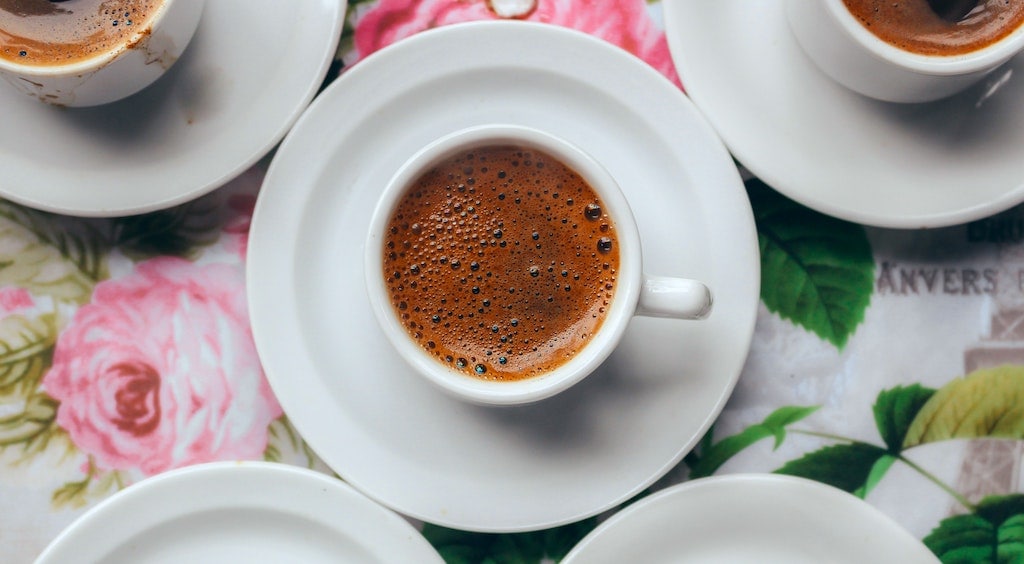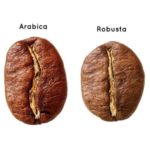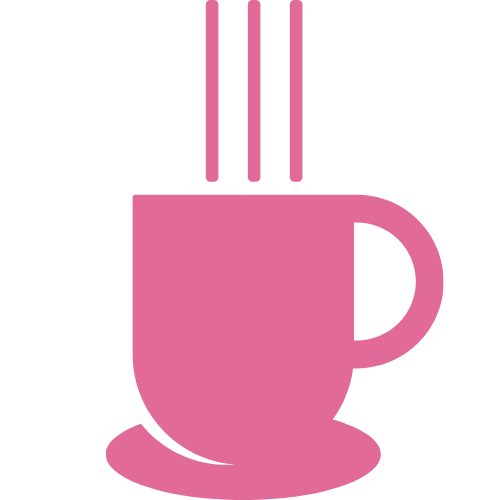
There are over 100 distinct species of coffee plants. But the most popular two among coffee manufacturers are Coffea Arabica and Coffea Canephora, which respectively produce the Arabica and Robusta beans.
Robusta beans are more circular and tend to be darker in shade, whereas Arabica beans have an elongated shape and a wavy central split, they’re also slightly larger in size.
Strongest Coffee beans & Coffee Brands:
If you’ve ever had one of these moments where it felt like the last two or ten cups of coffee you tanked up are just… Not quite cutting it in terms of caffeine content, you’ve landed on the right spot!
Strongest Coffee beans?

Robusta is the winner in terms of Caffeine content. In fact, Caffeine levels per 100g in unroasted Robusta coffee bean range from 2.2g – 2.7g while Arabica caffeine content is around 1.2g to 1.5g.
Arabica vs Robusta taste:
Robusta beans are generally described as bitter, harsh, with grainy notes of burnt rubber, and an aftertaste of peanuts. Arabica beans on the other hand are said to be smooth, floral, acidic, sweet, with flavors of chocolate and hints of fruits.
Robusta vs Arabica caffeine content:
Robusta coffee bean has twice the amount of caffeine (As detailed below), but Arabica is way more flavorful and contains almost 60% more lipids and a higher sugar concentration.
| Caffeine | Robusta coffee | Arabica coffee |
|---|---|---|
| Amount per 100g | 2.2 – 2.7g | 1.2 – 1.5g |
| A single roasted bean | ~10mg | ~6mg |
As a result, Arabica beans are more commonly used to produce high-quality coffee products. Whereas Robusta’s intense caffeine content makes it more prominent in espresso pods and instant coffees, it also serves as a filler agent to decrease the price of Arabica.
That said, a highly caffeinated drink also depends on how it was made.
Which is why, in this guide, I’ll share with you a quick and concise breakdown of how your coffee drink is affected by different processes depending on brewing methods and coffee drink types.
I’ll also list 6 of the strongest coffee brands you can find today.
Alright, let’s get the beans rolling!
Strongest Coffee brands in the world
Black Label Devil Mountain is labeled as the world’s most caffeinated coffee containing 1,555 mg per 12 fl. Oz. The incredible amounts of caffeine is due to their use of naturally-strong bean types.
Now If you really have that particular strong tolerance to caffeine. Then, fasten your seatbelt!
Below six coffee choices are definitely what you’re looking for!
Although truth be told, these are insane levels of caffeine, and by that, I mean way above what’s recommended. So, it’s also safe to check what the FDA advises before jumping in.
All good? Here we go!
Black Label Devil Mountain Coffee
This coffee is hands down the strongest coffee in the world. What a beast!
It contains a mind-blowing 1,555 mg per cup of 12 fl. Oz. Devil Mountain coffee – The black label is a high-powered gourmet coffee, manufactured using Non-GMO and Gluten-free organic production practices.
It is Labeled as the world’s most powerful coffee, rightfully so.
Very Strong Coffee
Oh, yeah, this coffee is exactly what it is, Very Strong. It is actually made from 100% Robusta beans, which are the secret ingredient to look out for in pretty much every insanely high-caffeinated coffee. So, if you desire a humongous caffeine hit to kick-start your day. Very strong coffee delivers a whopping 1,350 mg per cup of 12 fl. Oz.
Black Insomnia
Black Insomnia Coffee is definitely not here to mess around. Made solely from a blend of Arabica and Robusta beans, this coffee packs a 1105 mg of caffeine per cup of 12 oz.
Aside from its high caffeine content, Black Insomnia is also rich in hazelnut and caramel aromas and has a dark chocolate flavor to it. Both Ground and whole bean coffee packages are available on Amazon.
Cannonball Coffee Maximum Charge
Based in the UK, Maximum Charge is made from unique and quality Robusta coffee beans imported from sustainable farms in northern Rwanda. It is a medium roasted coffee with flavors of dark chocolate and toasted malt.
Unlike other high-caffeinated brands, it is not over-roasted, which makes the usually bitter taste less prominent. But that takes nothing away from its strength.
In fact, a serving of 12 fl. Oz will deliver over 1100mg worth of caffeine.
Biohazard Coffee
Claiming to be the strongest coffee on earth. Biohazard is made using single-origin Robusta beans. It has a fairly regular dark roast bitterness and an earthy taste. In terms of caffeine content, Biohazard boasts a staggering 928mg per cup of 12 fl. Oz.
well, if anything, this dose of caffeine might just wake you up from the deepest of sleeps. Here’s the link to Biohazard Coffee on Amazon.
Death Wish Coffee
Death Wish Coffee is a very strong coffee manufactured in New York using selected Arabica and Robusta coffee beans from all around the world. It delivers 54.2 mg of caffeine per fluid oz, which accounts for 650.4mg per cup of 12 fl. Oz.
Although it’s a dark roast, Death Wish is high in acidity and has a limited bitterness to it.
And there you have it, six of the most terrific javas around! if you have any more to include in this list, let me know in the comments below!
That said, you can’t mention high caffeine without talking about the massive effect brewing has on your coffee.
Strongest coffee roast?
Roasting is quite a complex process during which beans undergo heat treatments as well as physical and chemical changes that will define the color and flavor of the beverage.
Does it affect the beans’ caffeine content? Not really.
Dark roast vs Light roast caffeine content:
Contrary to popular belief, caffeine levels remain intact after roasting. Mostly due to the fact that the compound is very stable, even at +400°F temperatures. So basically, dark roast and light roast coffee contain pretty much the same amount of caffeine.
There’s a small catch though…
The roasting process has a direct effect on total mass loss. As in, the longer you roast coffee, the more of its density is lost.
Put simply, if you measure out your coffee using a scoop, light roast coffee will have slightly more caffeine because the beans are denser. But technically speaking, you’ve just scooped out more coffee mass.
So, the secret for more caffeine punch? Add more coffee.
Which brings us back to…
Which coffee brewing method has the most caffeine?
Brewing techniques make a big difference in providing that unique caffeine buzz because many factors can influence the final result.
Key brewing factors:
Grind size:
A finer grind size will provide more surface area for caffeine extraction; this guarantees improved results. Espresso for instance, which contains more caffeine per volume than drip coffee, uses a very fine grind size.
Water temperature:
Colder water significantly reduces caffeine extraction, while water that is too hot might cause substantial loss of quality.
Brew time:
Longer time means higher caffeine levels. An example here is Turkish coffee brew, which relies on soaking coffee ground into hot water for extended periods of time. Ultimately, a serving size of 59ml (2 fl. Oz) worth of Turkish coffee will contain around 60mg of caffeine.
Brewing gear:
A machine dwell time, its settings, and performance will also have a significant impact on your beverage.
Bean variety:
Are coffee beans 100% Robusta, Arabica, or a mixture of the two?
The Takeaway – Since there are so many parameters at play, acting on one will definitely require adjusting other factors to get the best mixture of flavor and caffeine.
For instance, if water is at room temperature, setting the brew time anywhere between 12 to 24 hours will produce a less acidic, highly caffeinated jolt of java. Aka the popular cold-brewed coffee.
Strongest coffee brewing method?
Taking into account the above factors, it is quite difficult to estimate the exact amount of caffeine content per drink as the smallest of variations can intervene with the brewing process.
| Coffee type | Caffeine content |
|---|---|
| Percolated (1 Cup of 8 fl. Oz) | 64-272mg |
| Turkish (1 Cup 8 fl. Oz) | 160-240mg |
| Espresso shot | 50-77mg |
| Drip or Filter (1 Cup 8 fl. Oz) | 115-175mg |
| French press (1 Cup 8 fl. Oz) | 80-135mg |
| Cold Brew (2 Cups 8 fl. Oz) | ~200 mg |
Keep this in mind though, it generally depends on the standard serving size for each drink.
For example, Espresso is highly concentrated in caffeine, but it’s also only served in tiny sizes. This is why a cup of drip coffee will contain more caffeine.
That said, start stacking up Espresso shots, and that’s when it really hits.
Brewing coffee for maximum caffeine?
If you want to make the most out of your coffee beans, you might also want to try the below hacks:
- Slightly increase coffee to water ratio.
- Match grind size to the requirements of your brewing machine:
✔ Coarse grind for French press and percolator.
✔ Medium grind for a drip coffee maker.
✔ Fine to extra-fine grind for Espresso and Turkish.
- Consider letting your coffee brew a little bit longer.
- Check your coffee bean quality.
Also, as mentioned before, it’s important to take into consideration how various brewing parameters interact with each other depending on your gear, type of beans…
Not to forget!
Each individual has a unique metabolism, so what works best for you might have an entirely different effect on the next person.
From bean variety to the smallest variation in its brewing process. there are many ways one can get that purely caffeinated coffee cup completely wrong.
But also, what a joy it is to discover the right combination for a nicely flavored cup of joe with an extra punch!
If this was helpful, please share!
Sources: coffee-statistics.com, ncausa.org, coffee.org, coffeechemistry.com, caffeineinformer.com
